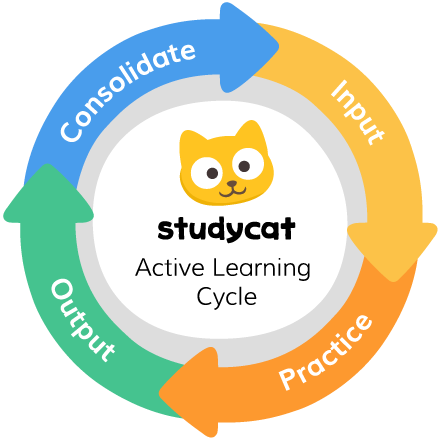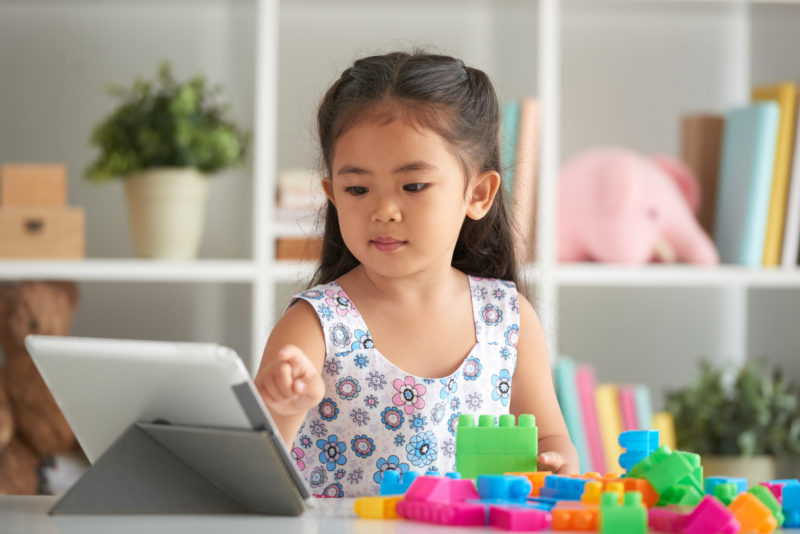
When it comes to teaching kids new knowledge and skills, most of us would agree that “active learning” is preferable to “passive learning”. The former involves more direct engagement of the learner, while the latter doesn’t leave much space for inquiry or individual scaffolding.
At Studycat, we’ve combined our decades of real teaching experience with the latest research on the science of learning in order to understand how active learning can occur in all different contexts.
Step 1: Input
The first step to any new learning endeavor is being exposed to new information. In this stage, kids are soaking up everything they can about something they’ve never learned before.
When any information — a sound, an image, a sentence, or anything else — enters the brain, electrical signals follow a pathway between neurons. If that information is familiar, those signals follow an existing pathway; but if the information is new to us, our brains need to work to create a brand new neural pathway.
“Input” is the process of doing that work — of making connections between neurons and forging new neural pathways in the brain.
So while this stage may seem like simply “looking and listening,” there’s actually a lot of hard work being done behind the scenes.
This step is absolutely crucial for any learning to occur. Without proper input, the active learning cycle cannot begin. But how it looks will vary according to each learner — and each learning environment.
In the classroom:
The teacher introduces a new skill or topic to students, guiding them through the basics and inviting them to share their previous knowledge on the subject or to ask questions. In some classrooms, this might look like exploration: the teacher provides resources for learning, while students pursue answers to their own curiosities about the subject.
In this stage, keeping students’ attention is vital. Without focusing on the input they’re receiving, kids won’t be able to move on to the next step in the learning process — and learning will effectively stop before it has really begun.
At home:
Outside of the classroom, learning doesn’t stop. Kids’ growing brains are always on the lookout for important new information to learn, and that information comes from anywhere and everywhere — including at home.
Kids receive input from observing their parents and other grown-ups, from older kids and family members, from reading books and watching movies.
So why is it that they don’t become carbon copies of everything they see? Well, remember that this is just the first step in the process of active learning — so just because they see good manners once doesn’t mean they’ll have good manners for the rest of their lives. In order to internalize that new information, they’ll need to continue to the next steps in active learning.
With Studycat:
When kids use our apps to learn a new language, they receive input at their level in a way that is fun and engaging. Studycat presents new skills and vocabulary at a pace that matches each individual learner, so they won’t feel bombarded with too much new information all at once.
We use songs, stories, and games to present new target language in a context that complements kids’ natural curiosities — but it doesn’t stop there.
Step 2: Practice
Once learners have been introduced to new information, it’s time to put it into practice. Practicing new skills in context can help our brains strengthen connections and deepen those neural pathways, so that we can process that new information faster and more efficiently every time we try.
Each time we practice or recall new knowledge, the pathways we worked so hard to create in Step 1 become even stronger. And the more we use a neural pathway, the more easily we can access it in the future.
Of course, practice is most valuable when it is done with guidance, so that the learner can receive feedback as they go. Timely feedback ensures that learners are strengthening the right pathways in the brain, so they won’t need to “relearn” something that they’ve been practicing the wrong way.
In the classroom:
After the initial input stage of presenting new information to the class, teachers will typically allow students the opportunity to put what they’ve just learned to practical use. This is the practice stage of the process, and it’s what we would usually call “class work.”
Practice in the classroom can look very different depending on the class, the teacher, and the skills being learned. Students may be working quietly on their own or noisily with a group. They may be practicing through discussion, writing, or some kind of creation. They might practice the same skill over and over until they get it right, or they might try it a bunch of different ways until they find one that fits.
No matter what practice might look like in the classroom, it should involve some form of instant feedback from the teacher. During this stage, it’s the teacher’s turn to observe how students are faring with their newfound skills — and to help them stay on the right track.
At home:
Outside of the classroom, some kinds of learning are still explicitly taught (for example, a parent teaching their child table manners). Just like in a classroom, these skills can be taught by an adult and practiced with guidance and feedback.
But what about the skills kids learn through observation — the ones we don’t necessarily “teach” them so intentionally?
As it turns out, kids practice these skills too. Many of the skills that kids learn through observation are social skills, and they’ll find ways to practice them in social situations — and look for feedback in how others react.
Whether they are copying speech patterns they heard in a favorite movie, displaying good (or bad) table manners by imitating an older sibling, or telling the same knock-knock joke a thousand times to see if it still gets a laugh — kids are always engaged in practice, and always reinforcing their learning through the feedback that they get from others.
With Studycat:
When kids learn a new language with Studycat, they are given plenty of opportunities to practice every skill with uniquely scaffolded activities. And because our activities provide instant feedback during practice, learners are able to correct any mistakes on their own and ensure that practice really does make perfect.

Step 3: Output
Once we’ve learned and practiced something new, it’s time to show the world what we’ve got. In this third step of the active learning process, learning is all about putting those new skills to good use — and demonstrating what we’ve learned.
You might have heard the expression, “Teaching is the best way to learn.” As it turns out, this is very true!
When we demonstrate what we’ve learned and explain it to others, it deepens those neural pathways even further. Showing others what we’ve learned also connects our learning to other parts of the brain involved in language and social skills, which deepens our own understanding as well.
Demonstrating new knowledge — or “output” — is about more than just proving that we’ve learned something. It challenges our brains to put that knowledge to use in a brand new way, and is an important part of the learning process.
In the classroom:
For teachers, this step is all about assessment. Have students learned what we wanted them to learn? Can they demonstrate and explain their learning in a way that shows how they’ve improved?
Assessment can be formal, as in an end-of-unit test or a culminating project. These types of output are students’ chance to demonstrate as much learning as possible. But informal assessment — observation, discussion, even homework — can be just as valuable.
Without the pressure of getting the best possible grade on a test, kids can demonstrate the output of their learning more candidly, so teachers can get a better understanding of how much they really know.
At home:
Even outside of school, kids demonstrate their newfound knowledge — even if their “assessment” isn’t necessarily as formal as it would be at school.
Output can occur in so many different ways, depending on the context of the learning. Kids might proudly show off their knowledge with a “Look what I can do!” or “Listen to this!”. They might demonstrate new skills in front of less familiar people, showing that they have moved beyond practice and are comfortable using their newfound learning.
With Studycat:
While most digital learning tools focus primarily on input and practice, Studycat includes a wide variety of voice games and other activities that allow learners to show off what they’ve been practicing.
Rather than just seeing and practicing target language, Studycat learners get the opportunity to use that language in context — which allows them to continue improving in all aspects of language.
Step 4: Consolidation
It may seem that output and assessment would be the last stage of the process, but in order for active learners to reach their full potential there is still one thing left to do: consolidate.
Consolidation is the process of putting everything together; input, practice, and output, along with any previous knowledge that can connect to new learning. When we do this, the pathways in our brains don’t just get stronger — they also connect to other existing neural pathways, adding to a vast network of knowledge in our brains.
The more we strengthen and connect these pathways, the easier it will be for us to access them in the future. Information that once required all of our attention will become almost automatic, freeing up space in our working memory to keep learning more new things — and keep up the cycle of active learning.
In the classroom:
Unfortunately, many of us have experienced classes where the active learning cycle stops at this point. We take the test, we get the grade, and we never revisit the topic again — meaning that the information is eventually lost, and those neural pathways we worked so hard to create just fade away.
Good teachers, however, know how to help their students consolidate their learning in a way that ensures it will be valuable for life.
This might look like making connections between recent learning and previous knowledge. It might mean reviewing important information regularly throughout the school year. And it might mean continuing to build upon the basics and work toward more advanced learning over time.
At home:
Because most active learning at home is somewhat informal and social in nature, consolidation of learning tends to occur in the same way.
As kids learn which skills and behaviors are most beneficial to them, they use them more often — strengthening and connecting those neural pathways even more. In this way, habits and patterns become second-nature. (The caveat? This applies to both good and bad habits — so make sure you’re there to guide them in the right direction through all of the previous steps!)
With Studycat:
At Studycat, we want kids to learn language skills that they can keep using, so we know the importance of consolidating what they learn.
That’s why each of Studycat’s games and activities builds upon previous lessons. And once learners master a new language skill, those skills will keep returning in future lessons to keep them fresh and relevant.
Active learning is a process, but it also takes the form of a cycle. Once learning is consolidated, it makes space for the input of new learning, and the cycle begins again.
When kids are given the opportunity to spend time in each of these four stages, it allows them to form and strengthen connections in their brains that will ensure their learning lasts a lifetime.


